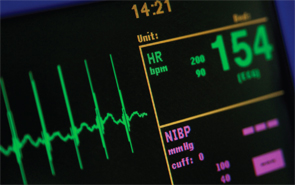
Heart rate variability is a feature of ANS dysfunction, although it is not universal in all patients with RA.
Image Credit: RHIMAGE/shutterstock.com
A growing understanding of the immunomodulatory effect of the autonomic nervous system (ANS) is edging closer to having clinical applications that could one day benefit patients with rheumatoid arthritis (RA). Researchers pursuing this as an alternative path to biomarkers are investigating whether autonomic status can be used to predict response to therapy.
Seattle-area rheumatologist and researcher Andrew Holman, MD, describes the alternate path he is investigating as “following the bread crumbs” left by other researchers who have been investigating the cross talk between the ANS and inflammation for many years.
“I have been interested in where these bread crumbs lead ever since Elenkov and Wilder’s article in 2000 that linked the sympathetic nervous system with the immune system and neurosurgeon Kevin Tracey’s 2002 article in Nature that described the cholinergic antiinflammatory reflex.1,2 And then when I heard Kevin Tracey’s lecture about ‘mind over immunity’ that he delivered to a standing-room-only crowd at the 2004 ACR/ARHP Annual Meeting, I was hooked,” he says.
Dr. Holman has been conducting research for several years exploring whether a patient’s autonomic status, as measured by heart rate variability (HRV), can be predictive of which patients are likely or unlikely to respond to anti-TNF therapy. He uses a proprietary five-minute, noninvasive device that measures HRV, which is manufactured by Omegawave LTD in Finland. It is the same device that several National Football League teams and the Manchester United Football Club use to measure their players’ cardiac, metabolic and central nervous system readiness for a game.

Dr. Holman
Dr. Holman’s one-year, double-blind, prospective, proof-of-concept study with 33 patients, published in 2008, found that those who have a poor HRV profile, defined as low parasympathetic and high sympathetic tone, were more likely to have a poor response to an anti-TNF agent.3
The exploratory study assessed clinical response at 6, 12, 26 and 52 weeks by using ACR20/50/70 scores and DAS28 response. At one year, patients who had a low parasympathetic tone had no chance of achieving ACR70, a 12% chance of ACR50 and a 40% chance of ACR20. Those with a high parasympathetic score had a 65% chance of an ACR70 response to the therapy at one year. “For a parasympathetic measure to predict ACR50 biologic response at 52 weeks, the positive predictive value was 87.5%, the negative predictive value was 88.0%, and the relative risk was 7.292 (p less than 0.001),” he says.
“Such high positive predictive value, negative predictive value, and relative risk support the claim that the ANS plays an important role in therapeutic response and may be useful in stratifying patient outcomes and identifying their need for adjunctive ANS optimization,” Dr. Holman says.
The next step in research, he says, is offering adjunctive treatment to raise the low parasympathetic score to a higher number “so that we can transform a nonresponder to an anti-TNF treatment to a responder.” He is scheduled to present an update on his research at the 2015 ACR/ARHP Annual Meeting in November, where he will present data highlighting the benefit of using adjunctive autonomic therapies with etanercept in 66 patients with RA. He will also be leading a study group on autonomic neuroregulation of RA during the meeting.
According to Kevin Tracey, MD, president and CEO of The Feinstein Institute for Medical Research and professor of molecular medicine and neurosurgery at Hofstra North Shore—LIJ School of Medicine in New York, this avenue of research is “provocative and potentially very important. Right now, we have these important TNF drugs that are very expensive, and some have black box warnings, and you would not want to give them to a patient unnecessarily. So the ability to make a simple test in a patient, a heart rate variability test, and say that a patient has a 90% chance of not responding to the drug is very important,” he says.
Inflammation Pathway
Several researchers have investigated the ANS as a pathway involved in inflammation. Elenkov and Wilder’s review article in Pharmacological Reviews described the sympathetic nerve as an “integrative interface between two supersystems—the brain and the immune system” (see Rheuminations, p. 10). Because the fields of neuroscience and immunology developed independently, an understanding of how these two systems interact had been relatively unknown or understood, the authors say.

Dr. Tracey
Dr. Tracey has focused on how the nervous system reflexively regulates the inflammatory response in real time, just as it controls heart rate and other vital functions. This inflammatory reflex is a neurophysiological mechanism that regulates the body’s immune system. More than 100 research articles have examined how activating this reflex could reduce inflammation through blockade of TNF production and other mechanisms.
He explained in a recent Scientific American article that when the inflammatory reflex does not function well, cytokines can lead to complications, such as RA.4 At SetPoint Medical, a biomedical technology company focused on the field of bioelectronics, which Dr. Tracey co-founded and where he now serves as a consultant, researchers are working on neuromodulation therapies for RA, a field called bioelectronics. They are testing the efficacy of stimulating the vagus nerve via an implantable microregulator, thus activating the inflammatory reflex and curtailing inflammation. Their pilot study with the implantable vagus nerve stimulation device was presented at the 2012 ACR/ARHP Annual Meeting.5
HRV: An Inflammatory Marker?
HRV as a potential inflammatory marker has been explored in previous research over the past several decades. A review article by Adlan et al in 2014 in Seminars in Arthritis and Rheumatism reported on evidence showing that ANS dysfunction is a feature of RA, although it is not universal in all patients with RA.6 This ANS dysfunction, they said, is characterized by low heart rate variability (HRV), reduced parasympathetic activity and elevated sympathetic activity.
Shimizu and colleagues in 2003 found a high prevalence of obstructive sleep apnea among patients with RA and that treatment with continuous positive airway pressure resulted in reduced RA activity.7 Pilot research presented at the 2014 ACR/ARHP Annual Meeting by Stavrakis and colleagues suggested that HRV measure could provide a sensitive inflammatory biomarker in systemic lupus erythematosus (SLE).8 Several conditions, such as sleep apnea and restless legs syndrome, are linked with a decreased parasympathetic tone that can be assessed by HRV.
Dr. Holman has established a research and diagnostics company, Inmedix LLC, that is exploring the efficacy of measuring HRV with the proprietary Omegawave device to help predict patient outcomes to anti-TNF therapy. The company is working to obtain FDA 510(k) clearance on the core technology platform, called ANS Neuroscan, and plans to conduct multicenter clinical trials. Eventually, the company hopes to gain FDA premarket approval (PMA) for the ANS Neuroscan as a patient management tool for RA treatment and, later, for SLE and multiple sclerosis.
Robert Ettlinger, MD, retired after 35 years as a rheumatologist in Tacoma, Wash., and who now serves on the Inmedix scientific advisory board, says the field of rheumatology continues to search for a reliable marker that could help identify which patients are likely to respond to certain therapies. “When treatment with regular DMARDs [disease-modifying antirheumatic drugs] and three different classes of biologics has failed and patients still have active disease, and you can’t get them down from 15 mg of prednisone, then you start thinking that ‘this chemistry set I am using in this patient is not working.’”
“Dr. Holman feels that if we know from the outset who the nonresponders are going to be, with a very high predictive value [by assessing parasympathetic tone via HRV], then maybe we wouldn’t keep knocking our head against the wall trying all these different therapies,” Dr. Ettlinger says. “We could cut to the chase with the first therapy adjunctively that could be expected to enhance this cholinergic antiinflammatory reflex, whether it be chemical or mechanical.”
Rheumatologist Lee S. Simon, MD, a former division director of the FDA’s Analgesic, Anti-inflammatory and Ophthalmologic Drug Products and now a principal at SDG LLC, FDA regulatory and clinical development consultants, says that some additional research with larger groups of patients will be needed before Inmedix can gain PMA for use of the HRV device for this indication. If future large clinical trials prove its effectiveness in predicting responsiveness to therapy, “that could be very helpful,” he says.
“I think this measures something that is consistent and meaningful. Whether it is that thing that can identify patients that have potential for no or lower responsiveness remains to be seen. There is some inferential evidence to suggest that that might be true, and it’s worth testing it out to see if it is indeed true. There is little to no risk involved,” Dr. Simon says.
“I haven’t seen anything yet that convinces me that it absolutely is right, and that is the whole point of doing a clinical trial. I wouldn’t say at this point that it is true, but it might be.”
Kathy L. Holliman, MEd, is a medical writer based in Beverly, Mass.
References
- Elenkov IJ, Wiider RL, Chrousos GP, Vizi ES. The sympathetic nerve—an integrative interface between two supersystems: the brain and the immune system. Pharmacol Rev. 2000 Dec;52(4):595–638.
- Tracey KJ. The inflammatory reflex. Nature. 2002 Dec 19–26;420(6917):853–859.
- Holman AJ, NG E. Heart rate variability predicts anti-tumor necrosis factor therapy response for inflammatory arthritis. Auton Neurosci. 2008 Dec 5;143(1–2):58–67.
- Tracey KJ. Shock medicine: Stimulation of the nervous system could replace drugs for inflammatory and autoimmune conditions. Scientific American. 2015 March 1;312(3):28–35.
- Koopman FA, Miljko S, Grazio S, et al. Pilot study of stimulation of the cholinergic anti-inflammatory pathway with an implantable vagus nerve stimulation device in patients with rheumatoid arthritis. 2012 ACR/ARHP. Abstract 451.
- Adlan AM, Lip GYH, Paton JFR, et al. Autonomic function and rheumatoid arthritis—a systematic review. Semin Arthritis Rheum. 2014 Dec;44(3):283–304.
- Shimizu M, Tachibana N, Nagasaka Y, Goto M. Obstructive sleep apnea in RA patients and effect of CPAP on RA activity. 2003ACR/ARHP. Abstract 187.
- Stavrakis S, Dyer J, Kamp S, et al. Heart rate variability: An inflammatory biomarker in systemic lupus erythematosus. 2014 ACR/ARHP. Abstract 866.
